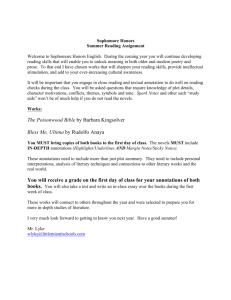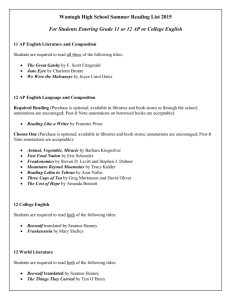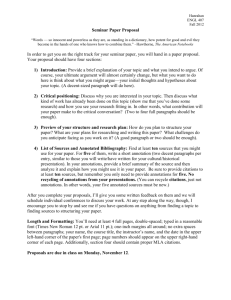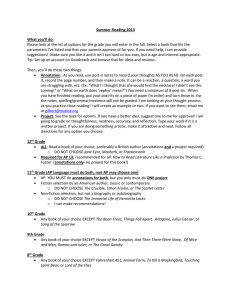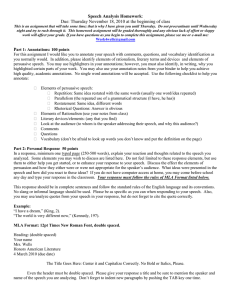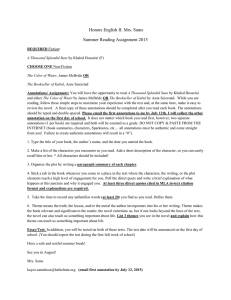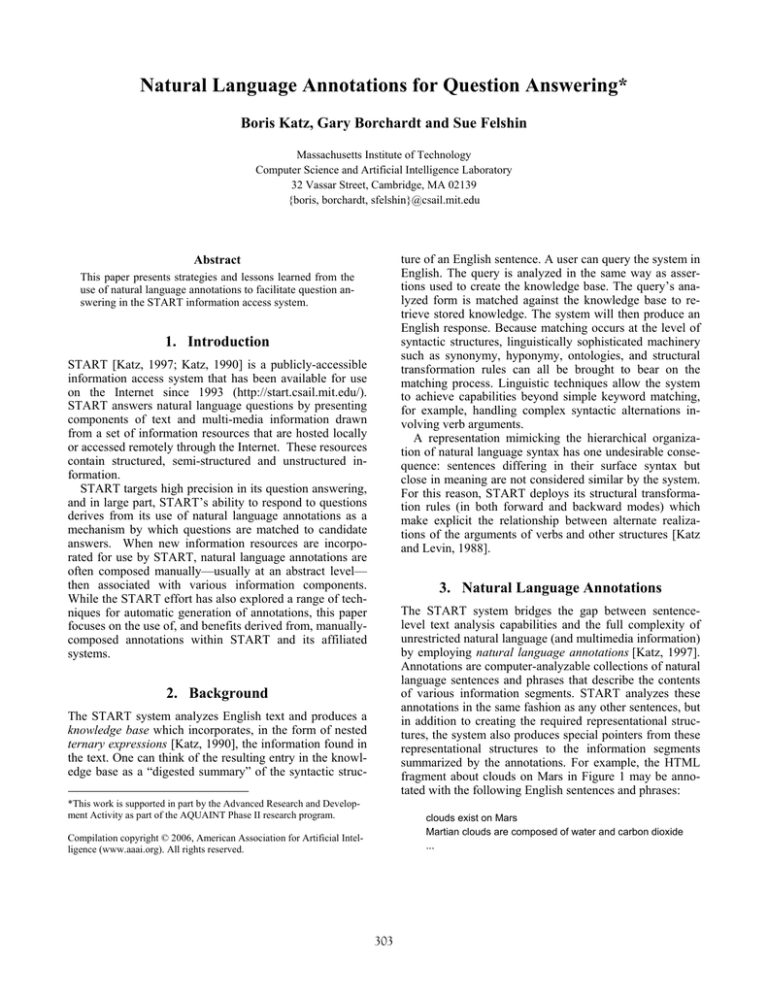
Natural Language Annotations for Question Answering*
Boris Katz, Gary Borchardt and Sue Felshin
Massachusetts Institute of Technology
Computer Science and Artificial Intelligence Laboratory
32 Vassar Street, Cambridge, MA 02139
{boris, borchardt, sfelshin}@csail.mit.edu
ture of an English sentence. A user can query the system in
English. The query is analyzed in the same way as assertions used to create the knowledge base. The query’s analyzed form is matched against the knowledge base to retrieve stored knowledge. The system will then produce an
English response. Because matching occurs at the level of
syntactic structures, linguistically sophisticated machinery
such as synonymy, hyponymy, ontologies, and structural
transformation rules can all be brought to bear on the
matching process. Linguistic techniques allow the system
to achieve capabilities beyond simple keyword matching,
for example, handling complex syntactic alternations involving verb arguments.
A representation mimicking the hierarchical organization of natural language syntax has one undesirable consequence: sentences differing in their surface syntax but
close in meaning are not considered similar by the system.
For this reason, START deploys its structural transformation rules (in both forward and backward modes) which
make explicit the relationship between alternate realizations of the arguments of verbs and other structures [Katz
and Levin, 1988].
Abstract
This paper presents strategies and lessons learned from the
use of natural language annotations to facilitate question answering in the START information access system.
1. Introduction
START [Katz, 1997; Katz, 1990] is a publicly-accessible
information access system that has been available for use
on the Internet since 1993 (http://start.csail.mit.edu/).
START answers natural language questions by presenting
components of text and multi-media information drawn
from a set of information resources that are hosted locally
or accessed remotely through the Internet. These resources
contain structured, semi-structured and unstructured information.
START targets high precision in its question answering,
and in large part, START’s ability to respond to questions
derives from its use of natural language annotations as a
mechanism by which questions are matched to candidate
answers. When new information resources are incorporated for use by START, natural language annotations are
often composed manually—usually at an abstract level—
then associated with various information components.
While the START effort has also explored a range of techniques for automatic generation of annotations, this paper
focuses on the use of, and benefits derived from, manuallycomposed annotations within START and its affiliated
systems.
3. Natural Language Annotations
The START system bridges the gap between sentencelevel text analysis capabilities and the full complexity of
unrestricted natural language (and multimedia information)
by employing natural language annotations [Katz, 1997].
Annotations are computer-analyzable collections of natural
language sentences and phrases that describe the contents
of various information segments. START analyzes these
annotations in the same fashion as any other sentences, but
in addition to creating the required representational structures, the system also produces special pointers from these
representational structures to the information segments
summarized by the annotations. For example, the HTML
fragment about clouds on Mars in Figure 1 may be annotated with the following English sentences and phrases:
2. Background
The START system analyzes English text and produces a
knowledge base which incorporates, in the form of nested
ternary expressions [Katz, 1990], the information found in
the text. One can think of the resulting entry in the knowledge base as a “digested summary” of the syntactic struc*This work is supported in part by the Advanced Research and Development Activity as part of the AQUAINT Phase II research program.
clouds exist on Mars
Martian clouds are composed of water and carbon dioxide
...
Compilation copyright © 2006, American Association for Artificial Intelligence (www.aaai.org). All rights reserved.
303
START parses these annotations and stores the parsed
structures (nested ternary expressions) with pointers back
to the original information segment. To answer a question,
the user query is compared against the annotations stored
in the knowledge base. If a match is found between ternary
expressions derived from annotations and those derived
from the query, the segment corresponding to the annotations is returned to the user as the answer. For example,
annotations like those above allow START to answer the
following questions (see Figure 1 for an example):
can describe, on the data side, a large table of population
figures for various cities. On the question side, this annotation, supported by our structural transformation rules, can
recognize questions submitted in many forms:
How many people reside in Chicago?
Do many people live in the metropolitan area of Pittsburgh?
What number of people live in Seattle's metropolitan area?
Are there many people in the Boston area?
In combination with other parameterized annotations
that describe the population figures in other ways (for example, using the terms “population” or “populous”), and
by parameterizing additional elements of annotations, a
large number of different questions can be answered using
a small number of parameterized annotations.
Are there clouds on Mars?
What do Martian clouds look like?
What is the chemical composition of Martian clouds?
Do you know what clouds on Mars are made of?
4. Handling Large Semi-Structured and
Structured Resources
Large resources, and particularly those that are semistructured or structured, typically contain significant
amounts of parallel information—similar information
about different entities. Parameterized annotations can be
used to represent large swaths of content in these resources, enabling a question answering system to easily
detect matches between its input questions and information
contained in the resources.
As an extensive application of parameterized annotations, our Omnibase system [Katz et al., 2002] supports the
START system by retrieving answers from a variety of
semi-structured and structured resources using object–
property queries generated by START. Omnibase acts as
an abstraction layer that provides a uniform interface to
disparate Web knowledge sources. Parameterized annotations serve as the interface between START and Omnibase, allowing the combined systems to answer questions
about a variety of topics such as almanac information (cities, countries, lakes, etc.; weather, demographics, economics, etc.), facts about people (birth dates, biographies, etc.),
and so forth. Some examples of object–property combinations are a country’s population, area, GDP or flag; a city’s
population, location or subway map; a famous individual’s
place of birth, date of birth, or spouse.
In order to successfully match input questions to parameterized annotations, START must know which terms can
be associated with any given parameter. Omnibase supports this need by acting as an external gazetteer for resource-specific terminology, with variants of terms being
calculated automatically from objects’ names, extracted
from semi-structured material in resources, or manually
defined.
When a parameter in an annotation matches a term in
the user’s question, the system “binds” the parameter to the
identifier(s) found by Omnibase. These identifiers are then
Figure 1: START responding to the question
"What are Martian clouds made of?" with an
information segment containing both text and
images.
With large resources, of course, it is impractical to annotate each item of content. However, resources of all
types—structured, semi-structured and unstructured—can
contain significant amounts of parallel material. Parameterized annotations address this situation by combining
fixed language elements with “parameters” that specify
variable portions of the annotation. As such, they can be
used to describe whole classes of content while preserving
the indexing power of non-parameterized annotations. As
an example, the parameterized annotation (with parameters
in italics)
number people live in the metropolitan area of city.
304
used by Omnibase in its dealings with the associated information resources.
Our IMPACT system (based on [Borchardt, 1992; Borchardt, 1994]) provides an additional example of the use of
parameterized annotations to support question answering
over semi-structured and structured resources. IMPACT
provides access to information in relational databases by
associating parameterized annotations with selections of
columns from database tables. By matching input questions to the parameterized annotations created for this purpose, START can perform a range of database selection
operations through IMPACT. Separately, IMPACT provides a layer of inference rules that can fuse information
from multiple sources and perform calculations concerning
time and events, and the heads of these inference rules are
also associated with parameterized annotations.
IMPACT’s use of parameterized annotations is described
more fully in [Katz et al., 2005].
• Parameterized annotations make it practical to index
large resources which contain significant amounts of
parallel information, using only a small number of annotations.
• Natural language annotations can provide assistance
toward the answering of complex questions.
Our ongoing research in the area of annotations focuses on
producing annotations semi-automatically, with minimal,
data-driven manual guidance based in the lexicon and on
information resource categorization.
5. Decomposing Complex Questions
Recently, we have been exploring the answering of complex questions such as “When was the president of France
born?” Such questions are interesting because answering
them typically involves information from different sources,
and indeed, in answering one part of such a question—e.g.,
“Who is the president of France?”, a system needs to identify an answer before proceeding to use that value—in this
case, Jacques Chirac—within another subquestion to be
answered—e.g., “When was Jacques Chirac born?”. Parameterized annotations can help, in that they can be used
to describe sets of simple questions that can be answered
independently. In addition, the mechanism of parameter
matching—via synonyms, hyponyms, etc.—plus the underlying mechanisms that supply answers to the simple
questions, can be used to bridge terminology differences
between resources, permitting a range of complex questions to be answered.
We have been exploring an approach whereby START
analyzes complex questions linguistically in order to isolate candidate subquestions, then checks, via its base of
annotated resource materials, to see if particular subquestions can be answered. This approach is described more
fully in [Katz et al., 2005]. Figure 2 provides an example
of START answering a complex question.
Figure 2: START answers a complex question
using its syntactic decomposition strategy.
START uses its ability to generate language to
explain how it derived its answer.
References
Borchardt, G. C., 1992. "Understanding Causal Descriptions of Physical Systems," in Proceedings of the AAAI
Tenth National Conference on Artificial Intelligence, 2-8.
6. Conclusions
Borchardt, G. C., 1994. Thinking between the Lines: Computers and the Comprehension of Causal Descriptions,
MIT Press.
Natural language annotations, in combination with sentence-level NLP, enable very high precision question answering:
• Ternary expressions can serve as a compact, yet expressive, representational foundation for natural language
based matching.
• Natural language annotations make it possible to index
text and non-text resources which cannot be analyzed by
current systems.
Katz, B. and Levin, B., 1988. “Exploiting Lexical Regularities in Designing Natural Language Systems,” in Proceedings of the 12th International Conference on Computational Linguistics (COLING '88)
Katz, B., 1990. “Using English for Indexing and Retrieving,” in P. H. Winston and S. A. Shellard (eds.), Artificial
Intelligence at MIT: Expanding Frontiers, volume 1, MIT
Press, Cambridge, MA.
305
Katz, B., 1997. “Annotating the World Wide Web using
Natural Language,” in Proceedings of the 5th RIAO Conference on Computer Assisted Information Searching on
the Internet (RIAO '97).
Katz, B., Felshin, S., Yuret, D., Ibrahim, A., Lin, J., Marton, G., McFarland, A. J. and Temelkuran, B., 2002. “Omnibase: Uniform Access to Heterogeneous Data as a Component of a Natural Language Question Answering System,” in Proceedings of the 7th International Workshop on
Applications of Natural Language to Information Systems
(NLDB 02).
Katz, B., Borchardt, G. and Felshin, S., 2005. “Syntactic
and Semantic Decomposition Strategies for Question Answering from Multiple Resources,” in Proceedings of the
AAAI Workshop on Inference for Textual Question Answering. Pittsburgh, PA, 35-41.
306

